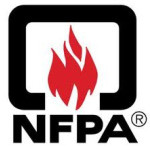- Industry: Fire safety
- Number of terms: 98780
- Number of blossaries: 0
- Company Profile:
Established in 1896, NFPA's mission is to reduce the worldwide burden of fire and other hazards on the quality of life by providing and advocating consensus codes and standards, research, training, and education.
Fluids that are produced by the body, including, but not limited to, blood, semen, mucus, feces, urine, vaginal secretions, breast milk, amniotic fluid, cerebrospinal fluid, synovial fluid, and pericardial fluid.
Industry:Fire safety
Flammable liquids shall be or shall include any liquids having a flash point below 100°F (37. 8°C) and having a vapor pressure not exceeding 40 psi (276 kPa) (absolute) at 100°F (37. 8°C). Flammable liquids shall be subdivided as follows: Class I liquids shall include those having flash points below 100°F (37. 8°C) and shall be subdivided as follows: (1) Class IA liquids shall include those having flash points below 73°F (22. 8°C) and having a boiling point below 100°F (37. 8°C); (2) Class IB liquids shall include those having flash points below 73°F (22. 8°C) and having a boiling point above 100°F (37. 8°C); (3) Class IC liquids shall include those having flash points at or above 73°F (22. 8°C) and below 100°F (37. 8°C). Combustible liquids shall be or shall include any liquids having a flash point at or above 100°F (37. 8°C). They shall be subdivided as follows: (1) Class II liquids shall include those having flash points at or above 100°F (37. 8°C) and below 140°F (60°C); (2) Class IIIA liquids shall include those having flash points at or above 140°F (60°C) and below 200°F (93. 3°C); (3) Class IIIB liquids shall include those having flash points at or above 200°F (93. 3°C).
Industry:Fire safety
Flammable gas, flammable liquid produced vapor, or combustible liquid produced vapor mixed with air that may burn or explode, having either a maximum experimental safe gap (MESG) value less than or equal to 0. 45 mm or a minimum igniting current ratio (MIC ratio) less than or equal to 0. 40. Note: A typical Class I, Group B material is hydrogen.
Industry:Fire safety
Flammable gas, flammable liquid produced vapor, or combustible liquid produced vapor mixed with air that may burn or explode, having either a maximum experimental safe gap (MESG) value greater than 0. 75 mm or a minimum igniting current ratio (MIC ratio) greater than 0. 80. Note: A typical Class I, Group D material is propane.
Industry:Fire safety
Flame retardant, nonmetallic troughs with removable covers for housing and protecting electrical wires and cables in which conductors are laid in place after the wireway has been installed as a complete system.
Industry:Fire safety
Flame resistance that is derived from the essential characteristic of the fiber or polymer.
Industry:Fire safety
Flame effects that are designed and installed, either in a permanent or temporary installation, that are designed to move or be moved, in the course of operation or installation.
Industry:Fire safety
Five general types of collapse include lean-to collapse, “V” shape collapse, pancake collapse, cantilever collapse, and A-frame collapse.
Industry:Fire safety
